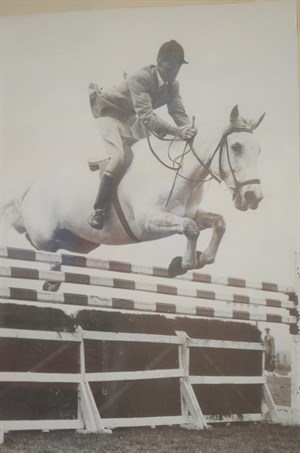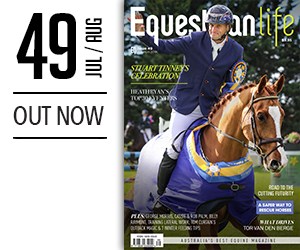|

The original photo of Bunty and Wedgewood
sent to EA by Barbara Buck
At the EA office, we received an old, black and white framed photo of Wyatt ‘Bunty’ Thompson, from a lovely lady named Barbara May Buck (nee Barker).
In the picture, Bunty is riding a grey horse called Wedgewood. Together they are sailing over a show jump with squarish bi-colour poles, with brush fill underneath.
The horse is in basic tack; a flat leather bridle, with a loose ring snaffle and a drop noseband. A flat-seat leather saddle is sitting straight on the horse’s back, no saddlecloth to be seen, completed with traditional fillis stirrup irons and a simple girth. Other than a pair of bell boots, Wedgewood is wearing nothing else. Bunty is carrying a crop and has a riding cap of the era pressed firmly on his head.
While the obvious age of the image leaves one imaging the equestrian scene of the time, the real significance of this photograph is that it was taken on the day the first-ever Australian equestrian team was selected for the Olympics.
Bunty Thompson, along with David Wood, Brian Crago, John Winchester, Ernie Barker (eventers) and Albert 'Bert' Jacobs (show jumper) were selected for the 1956 Olympic Games, collectively coached by Franz Mairinger.
Back in the day, Barbara was good friends with David, Bert and Ernie (she didn’t know the others as well, as they were from NSW).
Born on 11th December 1923, based in Victoria, Barb has seen a lot in her 95 years but describes her time spent riding and with horses as the best years of her life.
Curious to find out a little more to the story behind the picture of Bunty, we asked Barb to tell us about it...and so she did:
"I worked at the Waverley Riding School, which was run by the three Irving sisters Marjorie, Kay and Pippa.
I started in 1941 and worked there until I got married in 1960 (with a two year gap in the middle when I travelled overseas). My connection to them was that my Dad was first cousin with the three girls. Uncle Frank (the girls’ father) was my Dad's mother's brother.
In the lead-up to the selection, the Melbourne Royal Show had asked the Waverley Riding School to organize an entire week, (which would be the week after the Royal Show finished), at the Riding School for pre-selection of the Olympic team.
The Riding School were asked to look after all the horses and their riders during the week.
Kay [Irving] thought it was too much after a fortnight at the Royal Show, where they had numerous entries and commitments, and said she didn't think they could do it. Then Kay had an idea and said, "I've forgotten to enter one person in the Garryowen* in the Show - so if you can get her entered into the Royal Show, we'll commit at our end".
(*The Garryowen turnout event, which has been a feature of the Royal Melbourne Show for over 80 years honours Victorian equestrienne Violet Murrell, and her show horse Garryowen. In 1934 Garryowen died in a stable fire and 29-year-old Ms Murrell died trying to rescue him.)
The [Garryown] event is for 'everything' – ie, the way you turn yourself out, the way the horse turns itself out, the way you and the horse present yourself, the way you ride...basically everything about you and the horse, (personally I never liked it because you stood around for ages waiting to be judged).
Most people arrived on the weekend, ready to start the trials on the Monday.
People came with caravans and tents and I would estimate, that during the week, there were hundreds there. Franz Mairinger was there for the week, along with other international riders.
I didn't know John Winchester or Bunty Thompson so well, (because they were from NSW), but I knew David Wood, Bert Jacobs and Ernie Barker quite well. We used to see a lot of Bert, as he was a truck driver, and he used to drive our horses around to different shows.
Ernie was a dairy farmer from Dandenong, and we used to see a lot of him. He had a black Morris exactly the same as my Dad's and they often used to get them confused.
On the day of selection, my recollection is there were about 30 people who tried out. Waverley Riding School bedded down about 30 people. We also fed most of the people who came; Marjy did all the catering!
They eventually got it down to a few more than six and then they made the final selection.
This took place over approximately a week. There were three overseas selectors: John Sheddon from England, Franz Maringa from Austria - who ended up being the trainer and who had previously taught at the Spanish Riding School for 7 years, and one more whose name has escaped me.
When they'd finished the judging on the day of the selection, they called the six fellows out, but they had no idea whether they were selected or being asked to leave. They took photos of them (one is the photograph pictured), and then they told them they had been chosen. There were huge, mad and excited scenes that followed.
Some history on Franz is that Kay [Irving] had heard he was in Adelaide working at a furniture shop. Sergeant Roberts, who was head of the Mounted Police in Melbourne, had told Kay about Franz and that he used to work at the Spanish Riding School.
Kay contacted Franz and asked him if he would be willing to come from Adelaide for one day a week to work with the men who were trying out for the Olympics. Kay used to meet him at the train and put him back on the train. He really needed to start with scratch with the boys. They were good riders, but they knew nothing about dressage.
This was a wonderful part of my life and it's lovely to re-live it through the memories.”
As told by Barbara Buck, assisted in answering my questions with the writing help of her daughter Robin Ashley.
Source: Equestrian Australia
READ THE LATEST NEWS ARTICLES HERE

|

